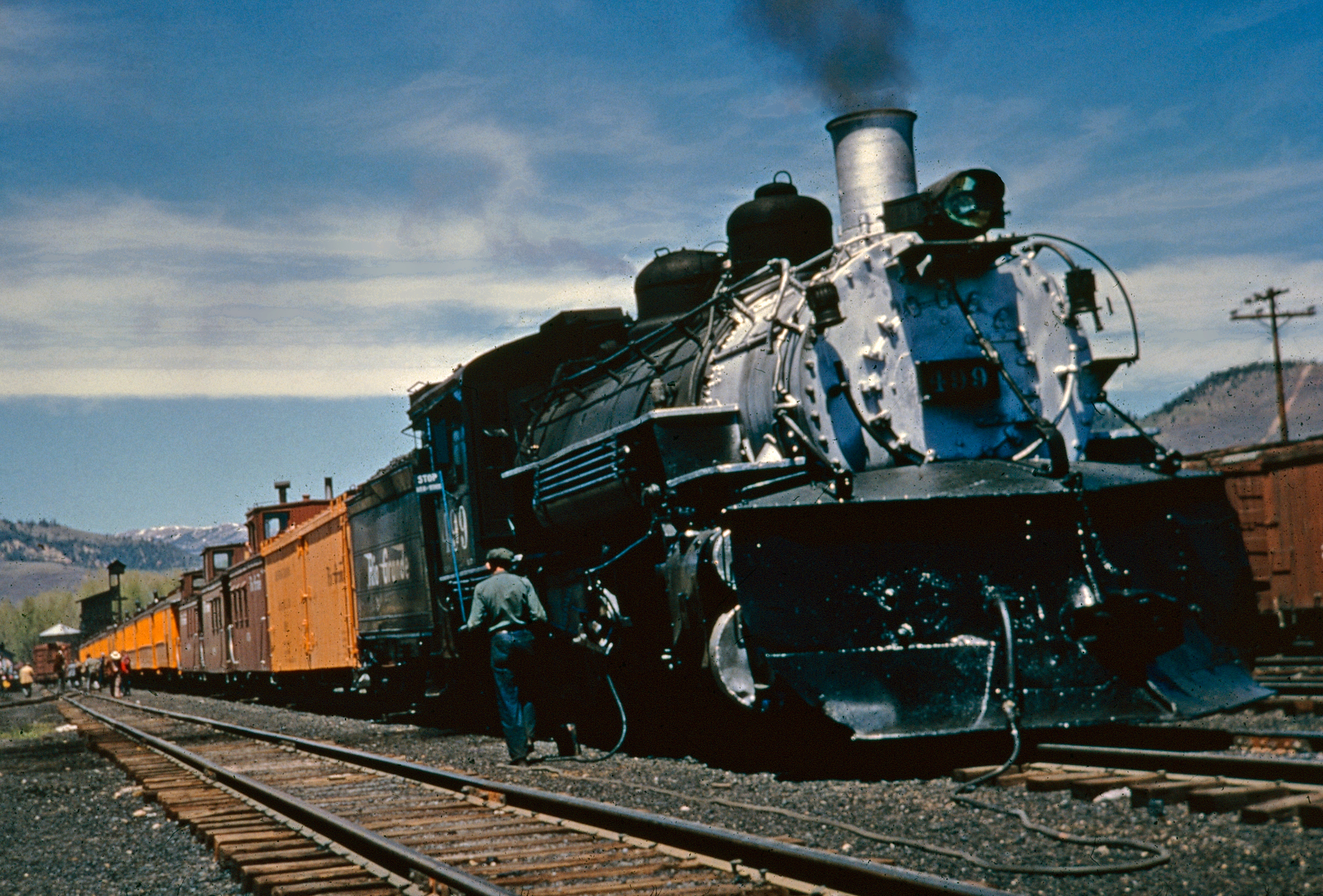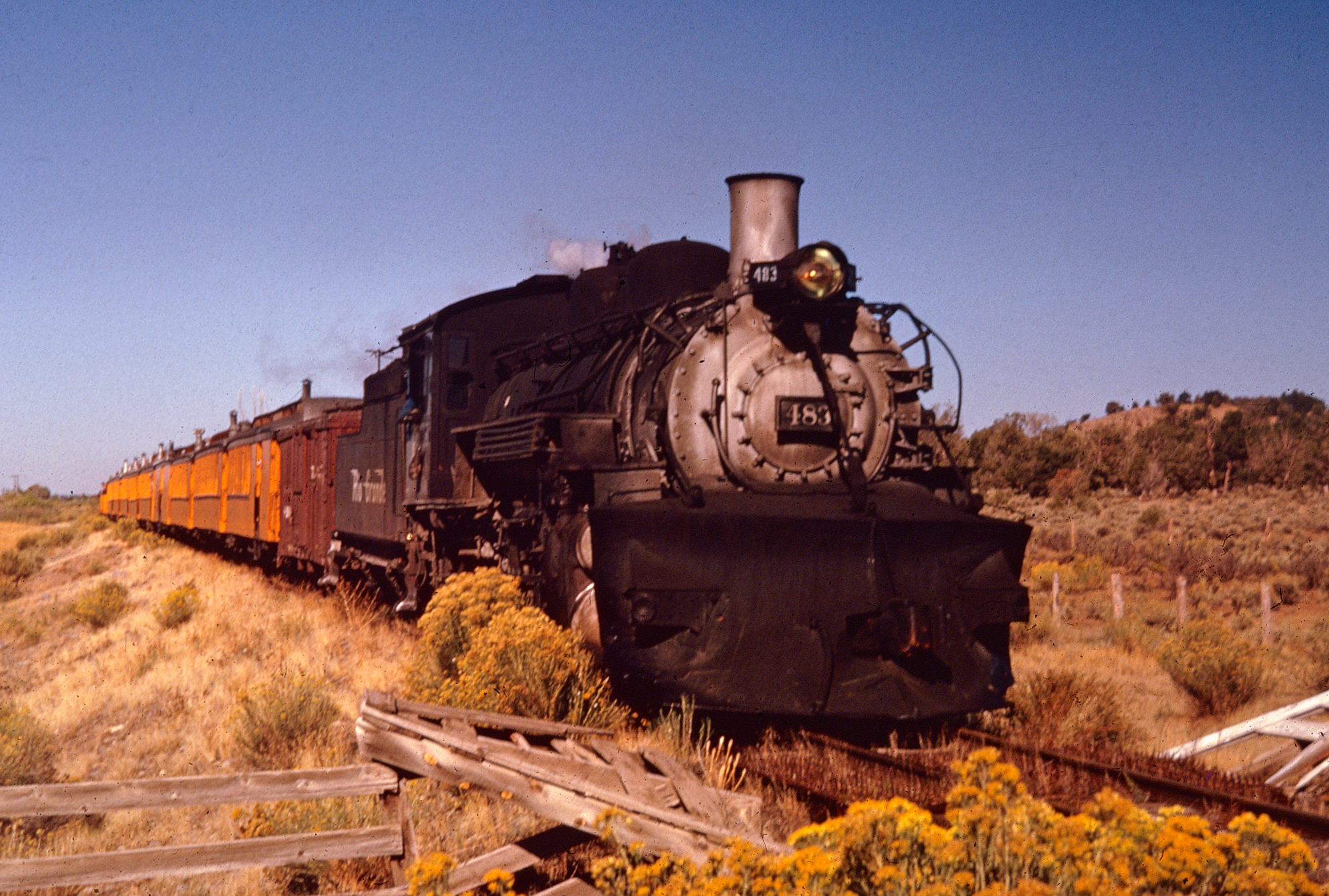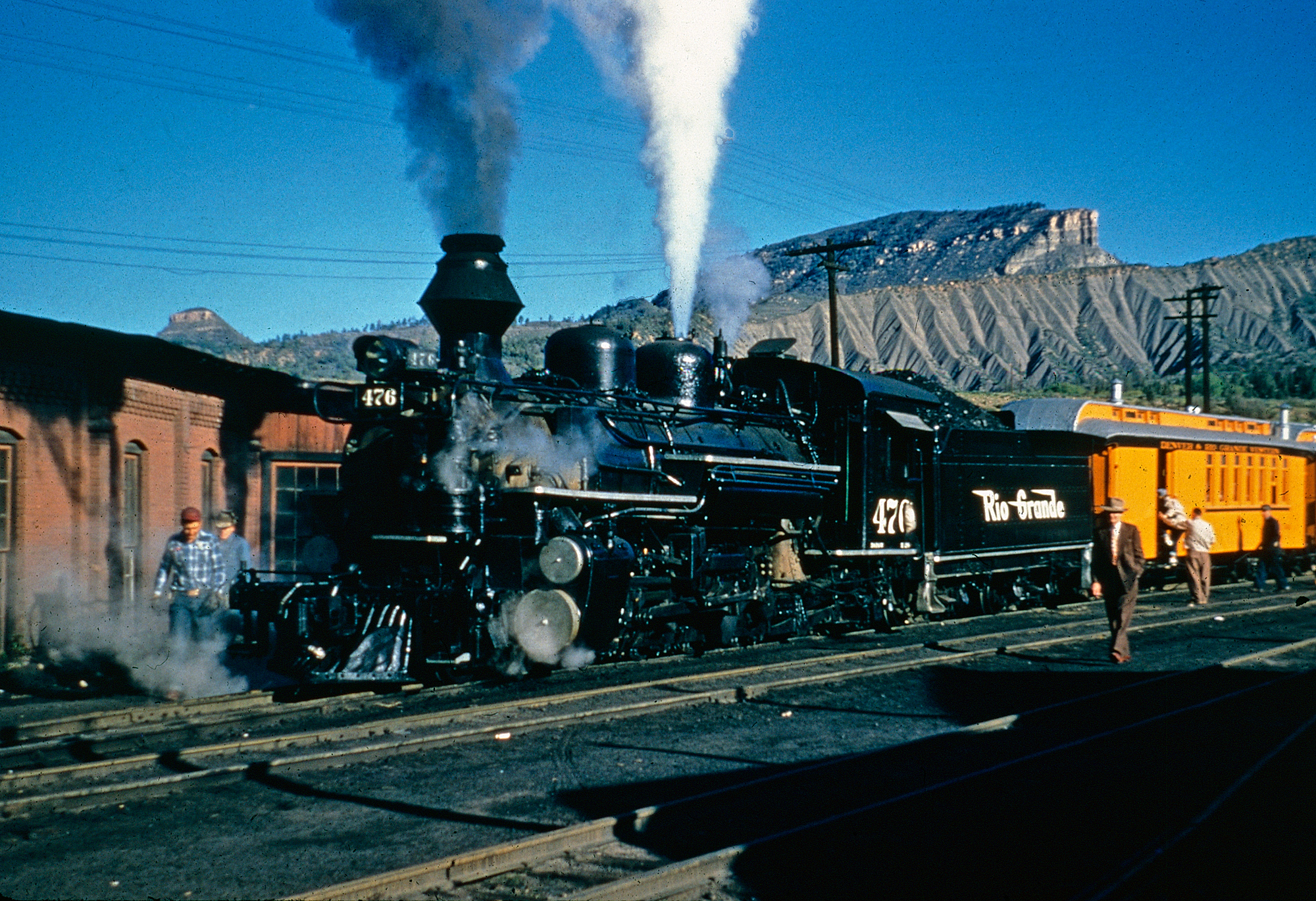Mississippi Export Railroad: Born In The Timber Industry
Last revised : August , 2024
By: Adam Burns
The Mississippi Export Railroad (MSE) is a short line with a rich history dating back to 1922. Headquartered in Moss Point, Mississippi, the MSE operates over a 42-mile line, linking Evanston in Mobile County, Alabama with Pascagoula, Mississippi.
The establishment of the MSE was driven by the need for transportation solutions in the burgeoning forest products industry of the early 20th century. Initially, it formed a crucial link between the local timber resources and major rail networks, facilitating the efficient movement of vast quantities of lumber, which catalyzed economic development in the region.
Over the decades, the MSE has continuously evolved, responding to changing market demands and economic conditions. In modern times, its service offerings have expanded far beyond timber, handling a diverse array of commodities such as chemicals, crude oil, steel, and automotive parts.
The railroad interchanges with four Class I's - including CSX, Canadian National, Canadian Pacific Kansas City, and Norfolk Southern - thereby offering transportation solutions from the Gulf Coast to broader national and international markets.
Its strategic importance to the supply chains of numerous industries underscores its role as an economic backbone for the Gulf Coast region.
The Mississippi Export exemplifies the dynamic adaptability and sustained relevance of short-line railroads in America's transportation network, marking over a century of operational excellence and commitment to economic resilience and growth.
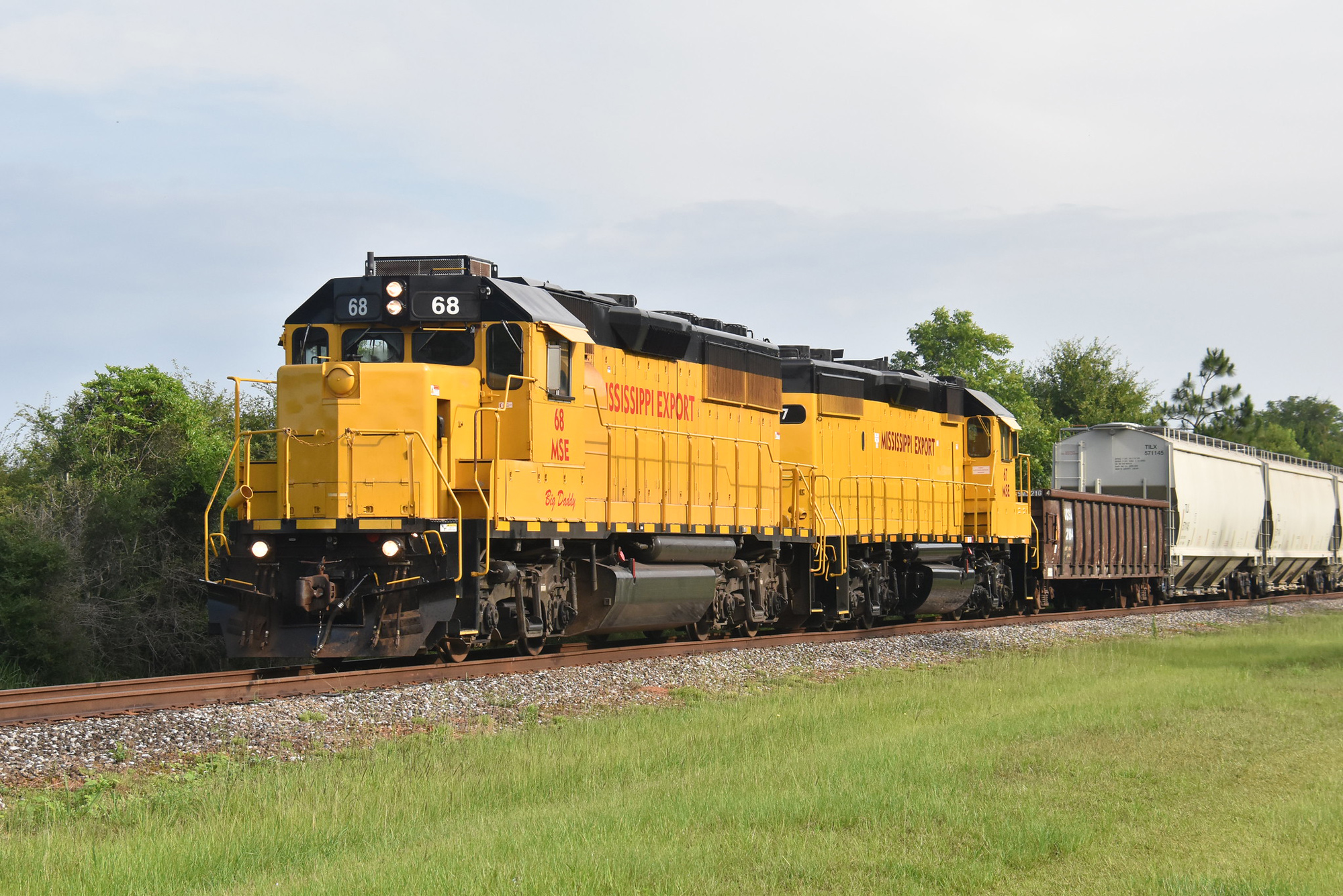 Mississippi Export GP50 #68 and GP38-2 #67 lead southbound train #51 at Lucedale, Mississippi on June 14, 2023. Doug Kroll photo.
Mississippi Export GP50 #68 and GP38-2 #67 lead southbound train #51 at Lucedale, Mississippi on June 14, 2023. Doug Kroll photo.Heritage
The Mississippi Export Railroad traces its origins to the Moss Point & Pascagoula Railroad (MP&P), which was established in 1894 and began operations between the two named cities the following year. Initially a modest operation with just 4 miles of track, the railroad experienced significant growth beginning in 1902, following acquisition by a local sawmill owner in Moss Point. Within a year, the MP&P had expanded by an additional 38 miles.
However, it faced severe challenges, including substantial damage from a hurricane in 1906. These hardships led to bankruptcy three years later. In 1912, new ownership took over, extending the line to a lumber mill in Vinegar Bend, Alabama. Reflecting its expanded geographic reach, the railroad was renamed the Alabama & Mississippi Railroad (A&M) in 1915.
Financial difficulties resurfaced during World War I, culminating in a 1920 filing with the Interstate Commerce Commission to abandon the entire line. Subsequently, the company was declared insolvent and entered receivership. In 1922, the bankrupt A&M was purchased by Gregory M. Luce, leading to its reorganization and rebranding as the Mississippi Export Railroad on on November 10, 1922.
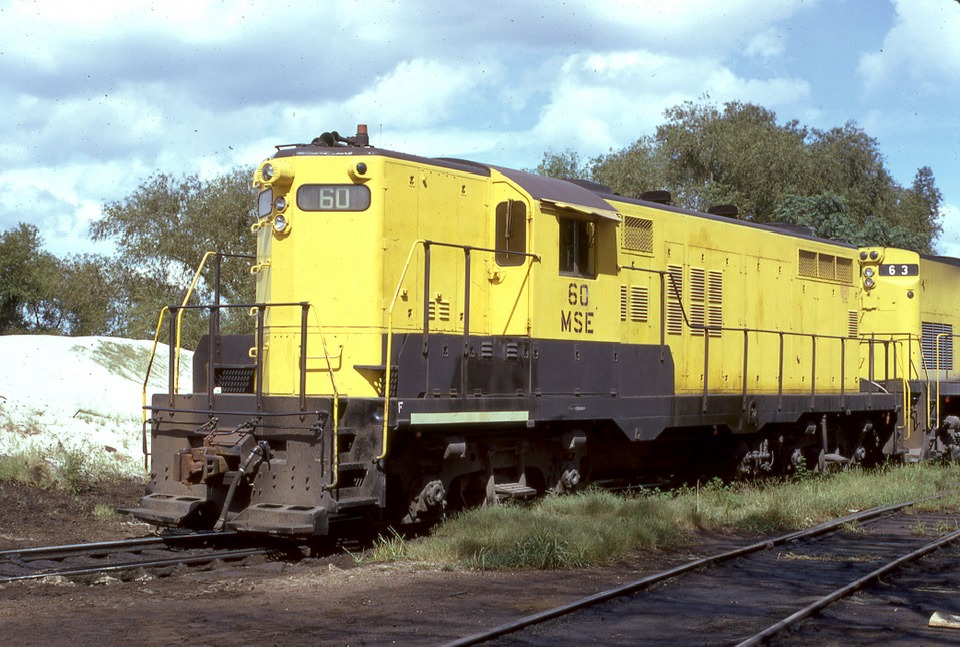 Mississippi Export GP9 #60, circa 1975. Note C420 #63 in the background. Warren Calloway collection.
Mississippi Export GP9 #60, circa 1975. Note C420 #63 in the background. Warren Calloway collection.Formation
Under Luce's direction the new railroad aimed to establish a rail link from Pascagoula, Mississippi, to a northern terminus at Luce Farms in George County, Mississippi. The company became officially organized just five days later on November 15, 1922.
On April 17, 1923, the Dantzler interests of Moss Point, Jackson County, acquired the southern segment of the defunct A&M from Horace C. Turner of Mobile, Alabama, for $110,000.
Formal ownership was secured with a deed on October 1, 1926. The acquired trackage spanned 42 miles from Pascagoula to Evanston, Mississippi. Originally constructed by the Pascagoula Northern Railroad in 1909-1910, this section had transitioned to the A&M in 1915.
The Mississippi Export completely rebuilt this line, officially commencing operations on February 1, 1923. The overall cost of reconstruction and equipment procurement totaled approximately $219,000, against authorized capital stock of $150,000, with $74,000 issued around 1926.
Timetable (1929)
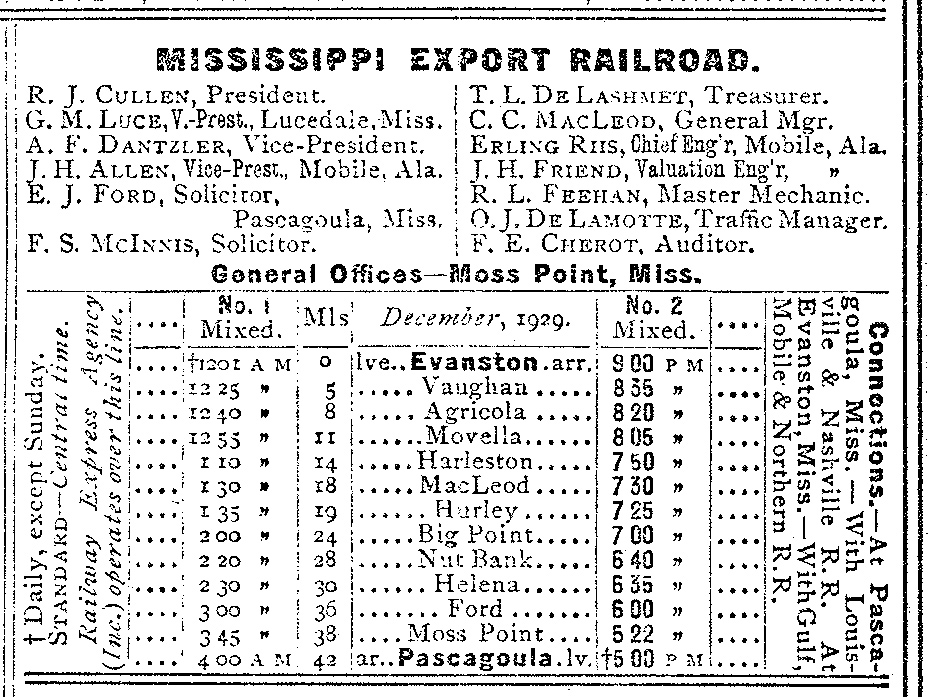
Interchange connections were made with the Gulf, Mobile & Northern (Gulf, Mobile & Ohio after 1940) at Evanston and the Louisville & Nashville at Pascagoula. The line traversed a largely flat, sparsely forested region near the Gulf of Mexico, where agricultural activities thrived, particularly around Evanston. During the 1920s, the railroad supported various industries such as a paper mill, veneer factory, and cannery.
The main line was initially laid with 60-pound rail, comprising both new and relay sections, with ballast consisting predominantly of earth surfaced with cinders and gravel. Key infrastructure included two significant metal bridges, notably a 425-foot structure over the Dog River featuring a mix of through-plate girders and a lengthy through-truss swing span on timber trestles and a steel-concrete pier. Additionally, numerous pile and frame trestles dotted the route.
Transitioning to modern power, the Mississippi Export acquired its first diesel locomotives in 1941 and completed full dieselization by the end of 1946, marking a significant milestone in its operational history.
Steam Roster
| Road Number | Wheel Arrangement | Builder | Construction Number | Completion Date | Heritage |
|---|---|---|---|---|---|
| 201 | 2-8-0 | Roanoke Shops (N&W) | 85 | 1/1890 | Built as Norfolk & Western #223. Became Mississippi Export #201 on 12/27/1922. |
| 202 | 2-6-0 | Baldwin | 10979 | 6/1890 | Built as Cincinnati, New Orleans & Texas Pacific (Southern) #87. Became Mississippi Export #202 on 8/14/1923. |
| 61 | 2-6-0 | Baldwin | 23512 | 1/1904 | Built as Shreveport & Red River Valley #61. Became Mississippi Export #61 on 8/28/1924 following #201 trade-in. |
| 33 | 2-8-0 | Baldwin | 17691 | 4/1900 | Built as Gulf & Ship Island 1st #15. Became Mississippi Export #33 in 11/1928. |
| 34 | 2-8-0 | Rogers | 4343 | 7/1890 | Built as Richmond & Danville #563 (Southern #4). Became Mississippi Export #34 on 8/1/1930. |
| 35 | 2-8-0 | Baldwin | 8923 | 12/1887 | Built as Richmond & Danville #530 (Southern #57)l. Became Mississippi Export #35 on 8/9/1930. |
| 36 | 2-8-0 | Baldwin | 29386 | 11/1906 | Built as Central of Georgia Railway #1212/#212 (1925). Became Mississippi Export #36 in 3/1936. |
| 37 | 2-8-0 | Baldwin | 29323 | 10/1906 | Built as Central of Georgia Railway #1209 (2nd)/#209 (1925). Became Mississippi Export #37 in 3/1936. |
| 38 | 2-8-0 | Baldwin | 53238 | 5/1920 | Built as Davison Sulphur & Phosphate Company #2 (Mina Carlota, Cienfuegos, Cuba). Became Mississippi Export #38 on 7/12/1938. |
| 39 | 4-6-0 | Baldwin | 25017 | 1/1905 | Built as Mobile, Jackson & Kansas City #80. Became Mississippi Export #39 in 1940. |
Diesel Roster
| Road Number | Model Type | Builder | Completion Date | Serial Number | Notes |
|---|---|---|---|---|---|
| 44 | 44-Tonner | GE | 10/1940 | 12914 | Acquired new. Sold to Red River & Gulf (#44). |
| 45 | 44-Tonner | GE | 12/1940 | 12945 | Acquired new. Sold to Pullman Standard (#44). |
| 46 | 70-Tonner | GE | 12/1946 | 28509 | Acquired new. Sold to Southwestern Portland Cement (#407). |
| 47 | 44-Tonner | GE | 12/1941 | 15024 | Sold to Fernwood, Columbia & Gulf (#D6). ex-Irex #502; built as Fort Dodge, Des Moines & Southern #502. |
| 48 | 70-Tonner | GE | 10/1951 | 31168 | Acquired new. Sold to St Johnsbury & Lamoille County (#53). |
| 49 | 70-Tonner | GE | 6/1950 | 30446 | Sold to Helena & Northwestern (#70). |
| 50 | 70-Tonner | GE | 2/1953 | 31724 | Acquired new. Sold to St Johnsbury & Lamoille County (#54). |
| 60 | GP9 | EMD | 10/1957 | 23985 | Acquired new. |
| 61 | NW5 | EMD | 1/1947 | 4149 | ex-Cargill #61; built as Fort Street Union Depot #2. |
| 62 | NW2 | EMD | 9/1948 | 5761 | ex-Nicolet Badger Northern #62; built as DT&I #914. |
| 63 | C420 | Alco | 9/1965 | 3425-01 | Acquired new. Sold. |
| 64 | SW1500 | EMD | 8/1973 | 73604-1 | Acquired new. |
| 65 | GP38-2 | EMD | 9/1975 | 75645-1 | Acquired new. |
| 66 | GP38-2 | EMD | 4/79 | 786213-1 | Acquired new. |
| 67 | GP38-2 | GMDD | 4/1986 | A4642 | Built as CP #3091. |
| 68 | GP50 | EMD | 5/1980 | 786257-3 | Built as C&NW #5052. |
| 95 | GP40 | EMD | 12/1966 | 32364 | ex-CSXT #6671, ex-Seaboard System #6671, es-Seaboard Coast Line #1514, built as Atlantic Coast Line #929. |
| 4301 | SW900 | EMD | 9/1960 | 26157 | ex-KCS #4301, built as Corinth & Counce Railroad #901. |
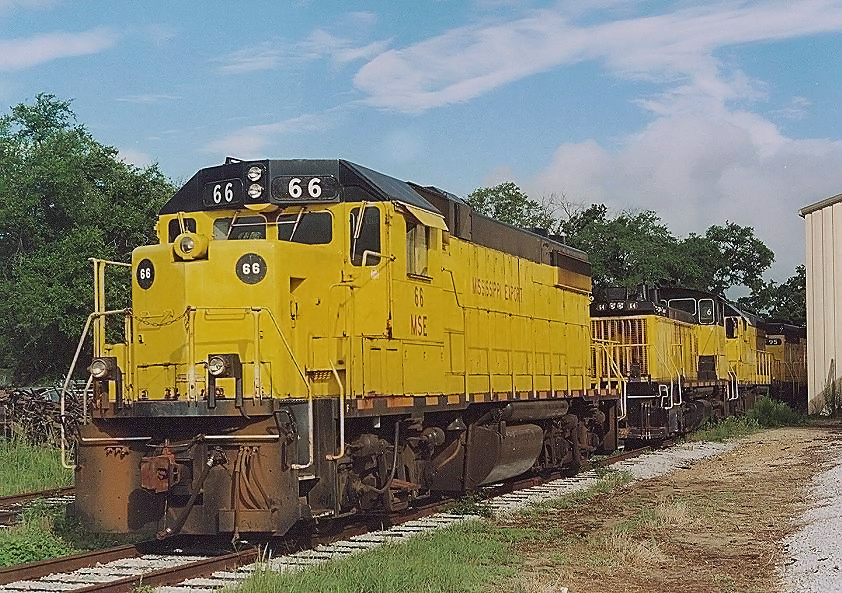 Mississippi Export GP38-2s #66, #65, SW1500 #64 and GP40 #95 layover outside the shop at Moss Point, Mississippi on June 7, 2003. Doug Kroll photo.
Mississippi Export GP38-2s #66, #65, SW1500 #64 and GP40 #95 layover outside the shop at Moss Point, Mississippi on June 7, 2003. Doug Kroll photo.Present Day
The Mississippi Export experienced significant growth during the 1950s, attracting new customers such as a paper mill, chemical plants, and a pet food manufacturer. This period of expansion continued with the opening of a major grain elevator in Pascagoula in 1961, which further boosted business. The railroad gained national attention when it was featured on the news program "On the Road" in 1974.
In the late 1990s, the Mississippi Export began playing a pivotal role in the expansion of the Helena Industrial Park in Moss Point. This development effort culminated in 2013 with the completion of the Escatawpa River Barge Terminal, facilitating efficient cargo transloading between rail and maritime vessels.
As a Class III, the railroad serves a diverse array of local industries. The company boasts a full-service maintenance and repair shop for railcars and locomotives, complemented by extensive railcar storage facilities.
Additionally, it offers comprehensive track maintenance and repair services, along with strategically located transloading terminals. The railroad's partnership with AO for tank car cleaning and waste disposal services further underscores its commitment to operational excellence and customer service.
Recent Articles
-
Rio Grande 2-8-2 Locomotives (K-37): Specs, Roster, Photos
Apr 15, 25 12:57 PM
Rio Grande's Class K-37 Mikes were itsdge steamers to enter service in the late 1920s. Today, all but two survive. -
Rio Grande 2-8-2 Locomotives (K-36): Specs, Roster, Photos
Apr 15, 25 11:09 AM
The Rio Grande's K-36 2-8-2s were its last new Mikados purchased for narrow-gauge use. Today, all but one survives. -
Rio Grande 2-8-2 Locomotives (Class K-28): Specs, Roster, Photos
Apr 14, 25 10:24 PM
Rio Grande's Class K-28 Mikados were its newest narrow-gauge steam locomotives since the Mudhens of the early 1900s. Today, three survive.
